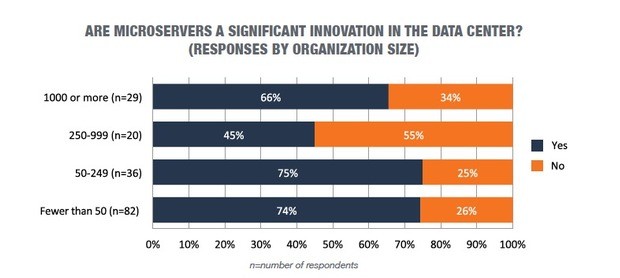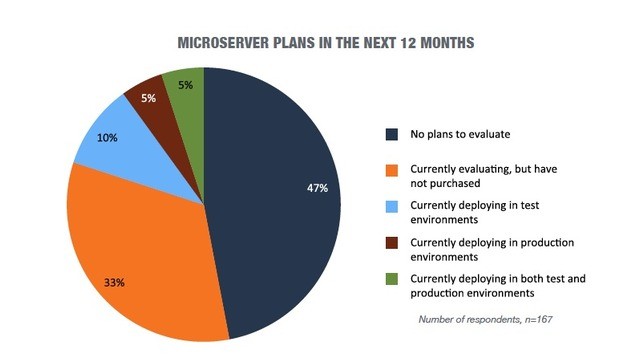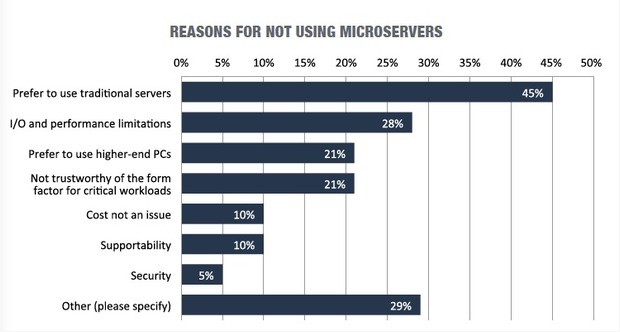There has been a lot of talk lately in tech circles about the possible applications for those cheap, weedy, and diminutive things called microservers, and how they could disrupt traditional high-end servers. According to a recent Tech Pro Research survey, 69% of businesses already consider them a significant innovation in their data centers. Avanced Micro Devices (AMD +7.62%) has been touting its leadership in microservers, while the market leader in enterprise server chips, Intel (INTC +0.31%), seems to be lagging behind a bit.

Source: Tech Pro Research
How big is the market for microservers?
The current size of the market for microservers is still a matter of conjecture, with widely varying estimates given by market leaders AMD and Intel. AMD estimates that the current market is about 4%-6% of the overall server market, with the potential to grow to 10%-20%. Intel, on the other hand, says that the overall market for its microserver chips Atom SoCs, Avoton, and Xeon E3, as well as everything that falls in the category of single-socket shared infrastructure, is just 1% of the total server-chip market, calculated on a volume basis.
Intel's Xeon Ivy Town Chip

Source: Intel
While there is no clear consensus on the actual size of the microserver market, the possible applications are clear-cut. Intel's Avoton chips and Xeon E3s are particularly suited for low-power applications such as cold storage. Cold storage is a term commonly used by cloud service providers to denote storage of data that is not accessed very often, such as photos.
As more companies migrate their core ERP functions to the cloud, the need for traditional vertical stack server setup is increasingly being replaced by software-defined networking, or SDN, and network function virtualization. Many companies now view microservers as a more attractive option due to their low power demands, low cost, and ability to scale well, which makes them ideal for serving static elements on high-traffic networks. Microservers are used to handle scaling lightweight tasks, thus freeing up larger servers to do the heavy lifting.
Several high-profile companies have deployed microservers in their data centers. Verizon (VZ +1.09%) uses microservers in its Verizon Cloud service. The servers are housed in Terremark data center, which the company bought for $1.4 billion in 2011.
Verizon's cloud service is aimed at government agencies, medium-sized businesses, and large corporations. The service is designed to connect to AWS and CloudStack. The company touts the value proposition of its cloud as increased efficiency, increased security, and enticing service-level agreements.
RedHat (RHT +0.00%) has built its OpenShift cloud computing PaaS using microservers. The service allows users to develop their own applications, then host and scale them in the cloud. App hosting works quite well with microservers, primarily because of their low power requirements, and the fact that an app-hosting environment typically involves high volumes of similar tasks.
Rubicon, a company that helps automate buying and selling of online ads, has also implemented microservers in its Rubicon Project. Rubicon uses the microservers to power its Revv platform for quick ad sales. The company says it opted for microservers in order to enhance the speed of international deals.
Revv microservers power billions of online transactions every month to help maintain high volumes of repeated transactions, with the ability to scale quickly whenever the workload increases.
Why microservers are not likely to replace traditional servers
Microservers are not likely to become as popular as their much larger counterparts due to several key limitations. According to the Tech Pro Research survey, only 5% of organizations are currently deploying microservers in production environments, with 47% having no plans to evaluate their viability. About 33% of organizations are evaluating microservers, but have not made up their minds to purchase them.

For organizations with no plans to evaluate microservers, the majority simply prefer traditional servers, with a significant percentage pointing at I/O, or input/output, limitations of microservers as the biggest reason why they have no plans to deploy them. Other issues, such as supportability, trustworthiness, and security, all cropped up during the survey.

Source: Tech Pro Research
Jason Waxman, Intel's head of the company's microserver division, pointed out during an interview last year that the desire for reliability and high performance are usually the biggest concerns for large data centers, while shared memory is usually a secondary requirement. Intel has E7 product lines for large, mission-critical databases with features such as error correcting circuitry.
Intel usually adopts a policy of being the leader in whatever kind of chips its customers want, and doesn't take chances, even when the potential market size remains unknown. The company's second-generation 64-bit Atom SoC is widely considered best-in-class, and will give the company a leg up on its competition.
Foolish takeaway
Although the potential size of the microserver market remains unclear, it appears as if the companies that are deploying microservers are doing so for specific needs, and not necessarily to replace their traditional servers. Intel, however, is not taking any chances and is trying hard to keep ahead of the curve, which will allow it to dominate the microserver market, no matter the direction it takes.
